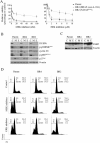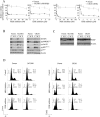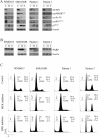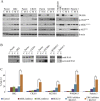Differential activity of MEK and ERK inhibitors in BRAF inhibitor resistant melanoma
- PMID: 24476679
- PMCID: PMC5528644
- DOI: 10.1016/j.molonc.2014.01.003
Differential activity of MEK and ERK inhibitors in BRAF inhibitor resistant melanoma
Abstract
Acquired resistance to BRAF inhibitors often involves MAPK re-activation, yet the MEK inhibitor trametinib showed minimal clinical activity in melanoma patients that had progressed on BRAF-inhibitor therapy. Selective ERK inhibitors have been proposed as alternative salvage therapies. We show that ERK inhibition is more potent than MEK inhibition at suppressing MAPK activity and inhibiting the proliferation of multiple BRAF inhibitor resistant melanoma cell models. Nevertheless, melanoma cells often failed to undergo apoptosis in response to ERK inhibition, because the relief of ERK-dependent negative feedback activated RAS and PI3K signalling. Consequently, the combination of ERK and PI3K/mTOR inhibition was effective at promoting cell death in all resistant melanoma cell models, and was substantially more potent than the MEK/PI3K/mTOR inhibitor combination. Our data indicate that a broader targeting strategy concurrently inhibiting ERK, rather than MEK, and PI3K/mTOR may circumvent BRAF inhibitor resistance, and should be considered during the clinical development of ERK inhibitors.
Keywords: Acquired resistance; BRAF inhibitors; ERK inhibitors; MEK inhibitors; Melanoma.
Copyright © 2014 Federation of European Biochemical Societies. Published by Elsevier B.V. All rights reserved.
Figures




References
-
- Aronov, A.M. , Tang, Q. , Martinez-Botella, G. , Bemis, G.W. , Cao, J. , Chen, G. , Ewing, N.P. , Ford, P.J. , Germann, U.A. , Green, J. , Hale, M.R. , Jacobs, M. , Janetka, J.W. , Maltais, F. , Markland, W. , Namchuk, M.N. , Nanthakumar, S. , Poondru, S. , Straub, J. , ter Haar, E. , Xie, X. , 2009. Structure-guided design of potent and selective pyrimidylpyrrole inhibitors of extracellular signal-regulated kinase (ERK) using conformational control. J. Med. Chem.. 52, 6362–6368. - PubMed
-
- Ascierto, P.A. , Schadendorf, D. , Berking, C. , Agarwala, S.S. , van Herpen, C.M. , Queirolo, P. , Blank, C.U. , Hauschild, A. , Beck, J.T. , St-Pierre, A. , Niazi, F. , Wandel, S. , Peters, M. , Zubel, A. , Dummer, R. , 2013. MEK162 for patients with advanced melanoma harbouring NRAS or Val600 BRAF mutations: a non-randomised, open-label phase 2 study. Lancet Oncol.. 14, 249–256. - PubMed
-
- Carlino, M.S. , Gowrishankar, K. , Saunders, C.A.B. , Pupo, G.M. , Snoyman, S. , Zhang, X.D. , Saw, R. , Becker, T.M. , Kefford, R.F. , Long, G.V. , Rizos, H. , 2013. Antiproliferative effects of continued mitogen-activated protein kinase pathway inhibition following acquired resistance to BRAF and/or MEK inhibition in melanoma. Mol. Cancer Ther.. 12, 1332–1342. - PubMed
-
- Chapman, P.B. , Hauschild, A. , Robert, C. , Haanen, J.B. , Ascierto, P. , Larkin, J. , Dummer, R. , Garbe, C. , Testori, A. , Maio, M. , Hogg, D. , Lorigan, P. , Lebbe, C. , Jouary, T. , Schadendorf, D. , Ribas, A. , O'Day, S.J. , Sosman, J.A. , Kirkwood, J.M. , Eggermont, A.M.M. , Dreno, B. , Nolop, K. , Li, J. , Nelson, B. , Hou, J. , Lee, R.J. , Flaherty, K.T. , McArthur, A.,G. , 2011. Improved survival with vemurafenib in melanoma with BRAF V600E mutation. N. Engl. J. Med.. 364, 2507–2516. - PMC - PubMed
Publication types
MeSH terms
Substances
LinkOut - more resources
Full Text Sources
Other Literature Sources
Medical
Research Materials
Miscellaneous

